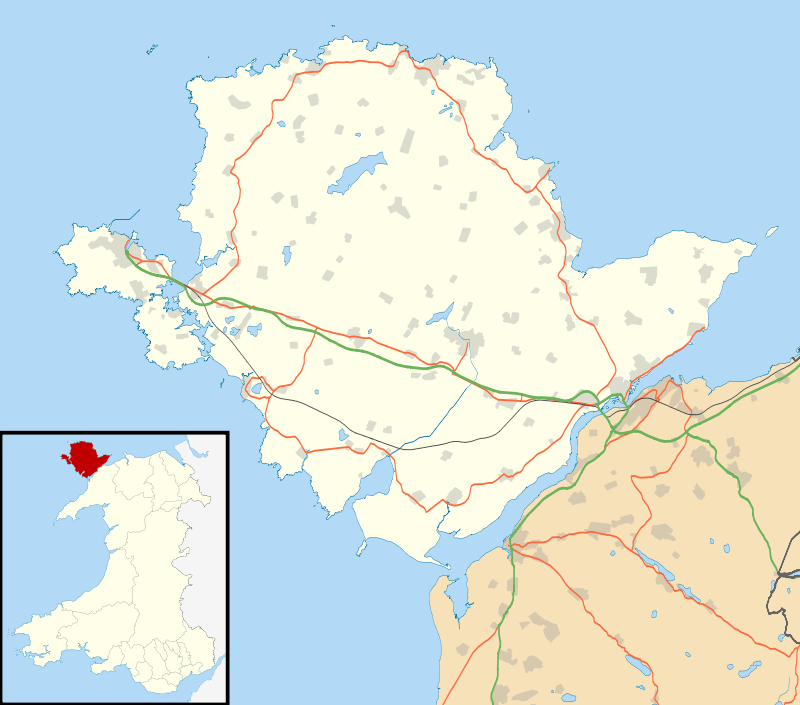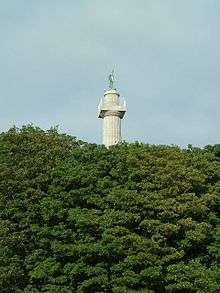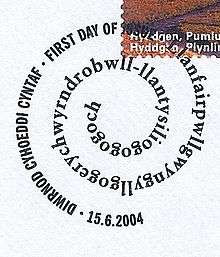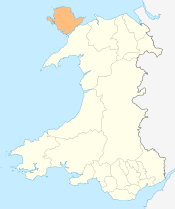Llanfairpwllgwyngyll
| Llanfairpwllgwyngyll | |
|---|---|
_-_geograph.org.uk_-_1058331.jpg) | |
 Llanfairpwllgwyngyll Llanfairpwllgwyngyll shown within Anglesey | |
| Population | 3,107 (2011 UK census) |
| OS grid reference | SH528716 |
| Community |
|
| Principal area | |
| Ceremonial county | |
| Country | Wales |
| Sovereign state | United Kingdom |
| Post town | LLANFAIRPWLLGWYNGYLL |
| Postcode district | LL61 |
| Dialling code | 01248 |
| Police | North Wales |
| Fire | North Wales |
| Ambulance | Welsh |
| EU Parliament | Wales |
| UK Parliament | |
| Welsh Assembly | |
Llanfairpwllgwyngyll or Llanfair Pwllgwyngyll (pronounced [ɬanˌvair puɬˈɡwɨ̞nɡɨ̞ɬ]) is a large village and local government community on the island of Anglesey in Wales, on the Menai Strait next to the Britannia Bridge and across the strait from Bangor. The name has been alternately shortened (Llanfairpwll) and lengthened (Llanfairpwllgwyngyllgogerychwyrndrobwllllantysiliogogogoch), and is also known as Llanfair PG.
At the 2001 census, the population of the community was 3,040,[2] 76% of whom spoke the Welsh language (Cymraeg) fluently; the highest percentage of speakers were in the 10–14 age group, where 97% spoke Welsh. By the time of the 2011 Census the population had increased to 3,107, of whom 71% were able to speak Welsh.[3] It is the sixth largest settlement on the island by population.
The long form of the name was invented for promotional purposes in the 1860s; with 58 characters it is the longest place name in Europe and the second longest official one-word place name in the world.[4]
History

A settlement has existed on the site of the village since the Neolithic era (4000–2000 BC), with subsistence agriculture and fishing the most common occupations for much of its early history. The island of Anglesey was at that point reachable only by boat across the Menai Strait. The area was briefly invaded and captured by the Romans under Gaius Suetonius Paulinus, temporarily abandoned in order to consolidate forces against Boudicca, then held until the end of Roman Britain.
With the withdrawal of the Roman forces, the area fell under the control of the early medieval Kingdom of Gwynedd. Under this feudal system, the residents worked small farms for the king. The rural nature of the settlement meant that the village had a population of only around 80 in 1563.
With the introduction of estates in the 16th century, much of the land was absorbed into the Earldom of Uxbridge, which later became the Marquisate of Anglesey; the inhabitants became tenant farmers on enclosures. In 1844, for example, 92% of the land in Llanfairpwll was owned by just three individuals. The population of the village boomed, with a population of 385 in the 1801 census and 83 houses, most of them in the old village (Pentre Uchaf, Upper Village).
In 1826, Anglesey was connected to the rest of Wales by the construction of the Menai Suspension Bridge by Thomas Telford, and connected with London in 1850 with the building of the Britannia Bridge and the busy North Wales Coast railway line, which connected the rest of Great Britain to the ferry port of Holyhead. The village decentralised, splitting into Upper Village (Pentre Uchaf), which was made up mainly of the older houses and farms, and the new Lower Village (Pentre Isaf), built around the railway station and consisting mostly of shops and workshops. The village became a hub of commerce, as the railways and road network brought traders and customers from across north Wales.
The first meeting of the Women's Institute took place in Llanfairpwll in 1915, and the movement (which began in Canada) then spread through the rest of the British Isles.[5]
Name
The long form of the name is the longest place name in the United Kingdom and one of the longest in the world at 58 characters (51 "letters" since "ch" and "ll" are digraphs, and are treated as single letters in the Welsh language).
The name means: Parish [church] of [St.] Mary (Llanfair) [in] Hollow (pwll) of the White Hazel [township] (gwyn gyll) near (go ger) the rapid whirlpool (y chwyrn drobwll) [and] the parish [church] of [St.] Tysilio (Llantysilio) with a red cave ([a]g ogo[f] goch).
This village was originally known as Llanfair Pwllgwyngyll and is sometimes still referred to as Llanfairpwllgwyngyll and was given its long name in the 19th century in an attempt to develop it as a commercial and tourist centre (see Significance of the name below). The village is still signposted Llanfairpwllgwyngyll, marked on Ordnance Survey maps as Llanfair Pwllgwyngyll and known to locals as Llanfairpwll or Llanfair. The railway station, despite having signs displaying the long name, is officially named Llanfairpwll.
The name is also shortened to Llanfair PG, which is sufficient to distinguish it from the many other Welsh villages with Llanfair in their names. Other variant forms use the longer name but with tysilio mutated to dysilio, and/or with a hyphen between drobwll and llan. In Welsh, the initial Ll may be mutated to a single L in some contexts.
Significance of the name

The long name was contrived in the 1860s to bestow upon the station the feature of having the longest name of any railway station in Britain, an early example of a publicity stunt. The village's website credits the name to a cobbler from the nearby village of Menai Bridge. According to Sir John Morris-Jones the name was created by a local tailor, whose name he did not confide, letting the secret die with him.[6][7] The current postmark shows the name Llanfairpwllgwyngyll, but there are contemporary examples of the longer name seen below.
The village was originally known as Llanfair Pwllgwyngyll ("St Mary's in Hollow of the White Hazel Township"). Pwllgwyngyll was the original medieval township where the village is today.[8] Old variants (with the Welsh spelling normalised) were Llanfair y Pwllgwyngyll (y = "(of) the") and Llanfair Ymhwll Gwyngyll (mh is a sandhi change (nasal mutation) from 'n p', and "yn" = 'in').
The village is split into two smaller villages, Llanfairpwllgwyngyll-uchaf (Upper Llanfairpwllgwyngyll), the original part of the village, and Llanfairpwllgwyngyll-isaf (Lower Llanfairpwllgwyngyll), the newer area nearer the railway station. These are occasionally referred to as Pentre Uchaf and Pentre Isaf (Upper Village and Lower Village).
Pronunciation
The long name of the village is pronounced [ˌɬanvairpʊɬˌɡwɨ̞ŋɡɨ̞ɬɡɔˌɡɛrəˌχwərnˌdrɔbʊɬˌɬantəˌsɪljɔˌɡɔɡɔˈɡoːχ] (![]()
The approximate pronunciation in English orthography is given at the station as: Llan-vire-pooll-guin-gill-go-ger-u-queern-drob-ooll-llandus-ilio-gogo-goch. The ch is a voiceless uvular fricative [χ] or voiceless velar fricative as in "Bach" ([bax]: see ach-Laut) in most varieties of German. The ll is a voiceless lateral fricative [ɬ], a sound that does not occur in English.
In popular culture
In the last line of the humorous Stephen Sondheim song "The Boy From", it transpires that the eponymous subject is moving to the village (from the fictional 'Tacarembo la Tumba del Fuego Santa Malipas Zacatecas la Junta del Sol y Cruz').
The name was used as a solution in a cryptic crossword compiled by Roger Squires for The Telford and Wrekin News when royalty visited Ironbridge in 1979 on the occasion of the 200th anniversary of the first iron bridge. It was submitted to Guinness World Records as the longest word to appear in a published crossword. The clue was "Giggling troll follows Clancy, Larry, Billy and Peggy who howl, wrongly disturbing a place in Wales (58)", where all but the last five words formed an anagram.[10]
The computer game Civilization V awards the "Longest. Name. Ever." Steam achievement to players for having a city named Llanfairpwllgwyngyll.[11]
Actress Naomi Watts once lived in the village with her grandfather.[12] Watts and Taron Egerton, who also spent years of his childhood in the village, both appeared on U.S. late-night talk shows where they pronounced the name of their home.[13][14]
In September 2015, Channel 4 Welsh weatherman Liam Dutton successfully pronounced the full name of the village during a forecast. Within 24 hours of being uploaded to YouTube by Channel 4, the video of the pronunciation had accumulated well over five million views,[15] and as of May 2018, the video had 17.3 million views.[16]
In November 2017 the full name of the village was used inside the House of Commons by a Member of the UK Youth Parliament from Wolverhampton, West Midlands during a closing speech from the Government Dispatch Box about the rights of LGBT+ Young People in the UK
Will Hay pronounces the name in a throwaway gag during his 1937 film “Oh, Mr. Porter”.
Climate
| Climate data for Llanfairpwllgwyngyll, 1961–1990, Altitude: 15 metres above mean sea level | |||||||||||||
|---|---|---|---|---|---|---|---|---|---|---|---|---|---|
| Month | Jan | Feb | Mar | Apr | May | Jun | Jul | Aug | Sep | Oct | Nov | Dec | Year |
| Record high °C (°F) | 16 (61) |
17 (63) |
22 (72) |
24 (75) |
28 (82) |
29 (84) |
31 (88) |
34 (93) |
27 (81) |
25 (77) |
18 (64) |
17 (63) |
34 (93) |
| Average high °C (°F) | 7.7 (45.9) |
8.0 (46.4) |
9.7 (49.5) |
12.1 (53.8) |
15.2 (59.4) |
17.9 (64.2) |
19.4 (66.9) |
19.3 (66.7) |
17.4 (63.3) |
14.6 (58.3) |
10.5 (50.9) |
8.7 (47.7) |
13.4 (56.1) |
| Daily mean °C (°F) | 5.2 (41.4) |
5.1 (41.2) |
6.6 (43.9) |
8.5 (47.3) |
11.3 (52.3) |
14.0 (57.2) |
15.7 (60.3) |
15.6 (60.1) |
13.9 (57) |
11.5 (52.7) |
7.8 (46) |
6.1 (43) |
10.1 (50.2) |
| Average low °C (°F) | 2.6 (36.7) |
2.2 (36) |
3.4 (38.1) |
4.9 (40.8) |
7.4 (45.3) |
10.1 (50.2) |
11.9 (53.4) |
11.9 (53.4) |
10.4 (50.7) |
8.3 (46.9) |
5.0 (41) |
3.5 (38.3) |
6.8 (44.2) |
| Record low °C (°F) | −9 (16) |
−8 (18) |
−7 (19) |
−3 (27) |
−1 (30) |
2 (36) |
5 (41) |
4 (39) |
1 (34) |
−1 (30) |
−4 (25) |
−8 (18) |
−9 (16) |
| Average rainfall mm (inches) | 107 (4.21) |
72 (2.83) |
85 (3.35) |
65 (2.56) |
65 (2.56) |
68 (2.68) |
74 (2.91) |
95 (3.74) |
98 (3.86) |
120 (4.72) |
130 (5.12) |
123 (4.84) |
1,102 (43.38) |
| Average rainy days (≥ 0.2 mm) | 19.7 | 15.0 | 18.9 | 14.1 | 18.9 | 13.7 | 13.1 | 15.1 | 15.8 | 18.7 | 19.5 | 19.5 | 202 |
| Average snowy days | 2.9 | 3.1 | 1.7 | 0.7 | 0.1 | 0.0 | 0.0 | 0.0 | 0.0 | 0.0 | 0.4 | 1.6 | 10.5 |
| Mean monthly sunshine hours | 49.6 | 73.5 | 105.4 | 153.0 | 195.3 | 183.0 | 173.6 | 164.3 | 126.0 | 93.0 | 57.0 | 40.3 | 1,414 |
| Source: Met Office[17] | |||||||||||||
| Climate data for Llanfairpwllgwyngyll, 1961–1990, Altitude: 15 metres above mean sea level | |||||||||||||
|---|---|---|---|---|---|---|---|---|---|---|---|---|---|
| Month | Jan | Feb | Mar | Apr | May | Jun | Jul | Aug | Sep | Oct | Nov | Dec | Year |
| Average rainy days (≥ 1.0 mm) | 15.6 | 11.2 | 13.0 | 10.4 | 10.9 | 10.3 | 9.4 | 11.7 | 12.3 | 15.0 | 15.7 | 15.1 | 150.6 |
| Source: Met Office[17] | |||||||||||||
| Climate data for Llanfairpwllgwyngyll, 1961–1990, Altitude: 15 metres above mean sea level | |||||||||||||
|---|---|---|---|---|---|---|---|---|---|---|---|---|---|
| Month | Jan | Feb | Mar | Apr | May | Jun | Jul | Aug | Sep | Oct | Nov | Dec | Year |
| Average rainy days (≥ 10.0 mm) | 2.5 | 1.7 | 2.0 | 1.5 | 1.2 | 1.6 | 2.2 | 2.7 | 2.8 | 3.4 | 3.8 | 3.5 | 28.9 |
| Source: Met Office[17] | |||||||||||||
Notable people
- Wilfred Mitford Davies (1895–1966) Welsh artist and publisher, went to school in the town
- Sir John "Kyffin" Williams, KBE, RA (1918–2006) Welsh landscape painter, lived at Pwllfanogl, Llanfairpwll
- John Lasarus Williams (1924–2004), known as John L, was a Welsh nationalist activist.
- Naomi Watts (born 1968), English actress and film producer, lived in the town as a child
- Taron Egerton (born 1989), Welsh actor, went to school in the town
- Siobhan Owen (born 1993), soprano and harpist from Adelaide, emigrated aged two
See also
- Llanfairpwll F.C., the village's football club
- List of long place names
References
- ↑ "Llanfair Pwllgwyngyll". www.ordnancesurvey.co.uk.
- ↑ "Check Browser Settings". statistics.gov.uk. Retrieved 31 March 2018.
- ↑ "Community population and percentage of Welsh speakers". Retrieved 18 May 2015.
- ↑ "Here's the story behind the 58-letter town name in Wales that everyone is talking about". Retrieved 18 September 2016.
- ↑ "Llanfairpwll - History of the village". www.llanfairpwllgwyngyllgogerychwyrndrobwllllantysiliogogogoch.co.uk. Retrieved 2018-05-16.
- ↑ David Barnes, The Companion Guide to Wales, 2005, p.318
- ↑ Eugene Byrne, "Pronounced how?", HistoryExtra, 22 July 2011
- ↑ Melville Richards, "Place Names", in An Atlas of Anglesey (Anglesey Community Council. Llangefni, 1972). The late Professor Melville was one of Wales' leading authorities on place names.
- ↑ "Llanfairpwllgwyngyll". Collins Dictionary. n.d. Retrieved 24 September 2014.
- ↑ "Blog Archive » Guardian 25,102 / Rufus". Fifteensquared.net. 30 August 2010. Retrieved 28 May 2013.
- ↑ "Steam Community :: Sid Meier's Civilization V :: Achievements".
- ↑ "Watch Jimmy Kimmel Live: Naomi Watts' Unpronounceable Town Name Online – Hulu". Hulu.
- ↑ Naomi Watts’ Unpronounceable Town Name. 6 March 2015 – via YouTube.
- ↑ Hugh Jackman and Jimmy Try Pronouncing Taron Egerton's Hometown. YouTube. 23 February 2016.
- ↑ "Liam Dutton pronounces Llanfairpwllgwyngyllgogerychwyrndrobwllllantysiliogogogoch perfectly". Mail Online. 9 September 2015.
- ↑ Channel 4 News (9 September 2015), Liam Dutton nails pronouncing Llanfairpwllgwyngyllgogerychwyrndrobwllllantysiliogogogoch, retrieved 20 July 2016
- 1 2 3 "Example climate estimate". Met Office.
External links
- Village website, listed in the 2002 Guinness Book of Records as the world's longest valid Internet domain name
- Llanfairpwllgwyngyll at Curlie (based on DMOZ)
- Explanation of village name
- Flickr photos
- Photos of Llanfair PG and surrounding area on geograph


